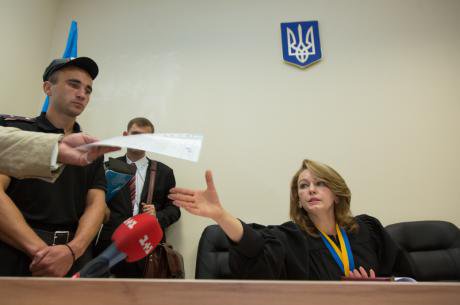
July 2014: Kyiv district court begins its review of the Ministry of Justice's appeal. (c) Inna Sokolovska / Demotix.On 16 December, a Kyiv district administrative court approved a claim by Ukraine’s Ministry of Justice. It sought to ban the country’s Communist Party (KPU).
Ukrainian society has come to see this court hearing as a ‘trial of communism’, and people’s sympathies have been divided precisely along these lines. However, the ministry’s claim, submitted in summer 2014, accused the KPU of aiding separatist movements in Ukraine’s east. That is, the claim contained no formal clause regarding the party’s ideology.
The ban has provoked mixed feelings from the Ukrainian left. Some celebrate the fall of the KPU: deemed the main barrier to the emergence of a real leftist movement in Ukraine, the party’s activities have discredited the very concept of left-wing politics here. Others have a gloomier outlook.
In the coming months, the KPU will appeal against the ban at a higher court—this story is far from finished. But to understand its significance for contemporary Ukraine, we need to understand where the KPU came from.
Whose/what opposition?
After the August coup of 1991 brought the Soviet Union to an end, Ukraine’s Supreme Court declared the country independent and banned the communist party for attempting a state coup. The Communist Party of Ukraine, the republican branch of the Soviet Communist party, thus came to an end. Two months later, though, a new Socialist Party of Ukraine was formed, and it became a refuge for many former members of the now banned KPU.
In 1993, the ban on communist party activity was lifted, and the first congress of a new Communist Party of Ukraine was held in Donetsk. The newly-created party declared itself the heir to the old Communist Party. And as the former ‘first faces’ of the USSR’s ruling party had found themselves successful post-communist careers, the leadership of the new KPU consisted mostly of middle-rank party functionaries, such as Petro Symonenko, the former second secretary of the party’s Donestk regional committee who leads it to this day.
Against a background of falling living standards in 1990s Ukraine, the KPU’s criticism of the government’s economic policy and manipulation of Soviet nostalgia quickly made it an influential force in the Verkhovna Rada, Ukraine’s parliament.
During the 1998 elections, for instance, the KPU made a strong showing, taking 25 per cent of the vote. Nevertheless, a significant part of Ukraine’s electorate that openly associated itself with the Soviet past considered the party anathema. Instead, this electorate opted for the centre-left Socialist Party (SPU) led by Oleksandr Moroz.
Then came a watershed moment in the history of the Communist Party of Ukraine—the 1999 presidential elections. Its rivals in the SPU had every chance of winning, and this is why Leonid Kuchma, independent Ukraine’s second president, did everything to lever the ‘unelectable’ KPU leader Symonenko into the second round of voting, rather than face the more popular Moroz.
The KPU’s activities have discredited the very concept of left-wing politics here
With this in the bag, Kuchma frightened the electorate with ease. Scare stories of Soviet restoration did their work. Despite criticising Kuchma for years, nationalist voters in western Ukraine ticked the box for the incumbent en masse, helping Kuchma remain president for a second term.
The 1999 election transformed the KPU into a convenient party of opposition—a safe channel for protest that posed little risk to the authorities.
Changing landscape
The 2000s saw Ukraine’s political landscape change. After the return of economic growth in 2000 and the Orange Revolution of 2004, populist movements with vague political programmes and slogans began to squeeze out the socially conservative ‘left-wing’ parties.
In this environment, the KPU’s popularity understandably fell. But it retained representation in parliament, and managed to avoid political oblivion thanks to its final and complete transformation into a right-wing conservative party.
Two points guided the KPU’s rhetoric in these years: pro-Russian nationalism and social equality. But while it condemned nationalism in words, in effect, the KPU became the main supporter of pro-Russian nationalism, coming out for the superiority of Slavic people over other ethnic groups and spreading Islamophobia in Crimea.
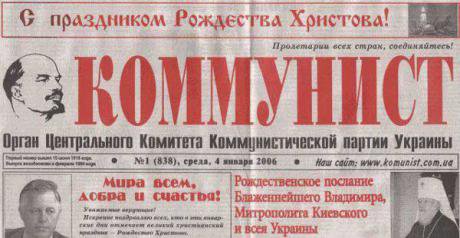
January 2006: Christmas greetings in Communist, the KPU party newspaper. CC norma40.ru.This left the communists ideologically similar to Europe’s other right-wing populist parties. For instance, on the basis of their programmes, it’s hard to differentiate between the KPU and France’s Front National—nationalising strategic industries, strengthening the role of the state in the economy and raising social welfare. Both parties can attribute their success to identity politics and playing on the conservative phobias of their economically vulnerable electorates.
Despite positioning itself as an heir to the Bolsheviks, the KPU usually sides with the powers that be. Leaving actual class analysis by the wayside, it claims to defend the interests of the ‘people’ against the ‘oligarchs’, yet combines this rhetoric with social conservatism (death penalty, pro-natalism and persecution of LGBT people). Meanwhile, the party also maintains close links with the Ukrainian Orthodox Church (Moscow Patriarchate), and it has always stressed the need to ‘defend the rights of canonical Orthodoxy’.
Despite positioning itself as an heir to the Bolsheviks, the KPU usually sides with the powers that be
The KPU is not averse to conspiratorial geopolitics, either: in response to Kazakhstan’s violent suppression of oil workers in Zhanaozen in 2011, the party newspaper condemned the rebellion for disturbing political stability at the possible behest of the American security services.
In the heady days of 2014, the KPU showed its true colours again. It voted for the 16th January laws, which the government of Viktor Yanukovych and Nikolai Azarov wished to use to introduce Internet censorship, seriously limit freedom of speech and assembly and expand the repressive powers of state organs. Most ironically of all, one of these laws sought to criminalise the act of ‘spreading social hostility’, a legal norm long used to persecute labour and left-wing activists in Kazakhstan and Russia.
Niche politics
Having built a niche for themselves as right-wing populists, Ukraine’s Communist Party were guaranteed a place in parliament right up until 2014. In the 2000s, the KPU easily converted the votes of their supporters into administrative and financial capital—with ministerial posts and the ability to guarantee votes in parliament. As one politician described it: ‘The communists weren’t always cheap, but they were reliable.’
For many years, the finance oligarch Konstantin Grigorishin sponsored the KPU. But Grigorishin, by his own admittance, stopped funding the party in 2012 after the KPU joined the governing coalition. They had ‘learned to support themselves’, with a leading party member appointed head of Ukraine’s customs service (a post with a reputation for corrupt rent).
2012 parliamentary elections: Petro Symonenko campaigning in Kherson, south east Ukraine. Image courtesy of symonenko.eu.The overthrow of Viktor Yanukovych in February 2014, however, caught the KPU by surprise. Many party functionaries did in fact support separatist movements, but on the whole the party refrained from publicly stating a position. Officially, they condemned the ‘anti-state coup’, but supported Ukraine’s territorial integrity.
Regardless of the ban, though, the party is in crisis. Many influential members broke ranks shortly after Maidan, and other prominent figures previously popular with the grassroots left the party in late 2015, taking three regional party organisations with them. The party leadership has reacted badly to the split, which has placed its future survival in doubt.
‘The communists weren’t always cheap, but they were reliable’
This has been reflected in its election results. At the October 2014 parliamentary elections, the KPU didn’t make it into parliament for the first time. And the reason isn’t repressions. (In the ‘Donetsk People’s Republic’, for instance, they were barred from participating.) Instead, the annexation of Crimea and armed conflict in the east have left a large part of the KPU’s traditional electorate in the south east without access to the ballot box—and the KPU out of the Rada.
Since then, the KPU has had to make new allies. In October’s regional elections, it balloted together with the newly-forged ‘Left Opposition’ movement together with parties considered even more nationalist and religious. (Confusion warning: Ukraine has two parties called ‘Left Opposition’.) The KPU has also started a new ‘non-communist’ project, the New State party, which aims to tap into concerns over rising tariffs and the government’s plans for privatisation.
While it received disappointing results at the recent elections, the ex-KPU still has a chance of continuing its political life. After all, the oligarchs are still interested in pro-Russian protest voices at election time, and the ‘new and improved’ KPU will be merely less independent than before.
A popular cause
As stated before, some people see the removal of the KPU a necessary step towards building a left-wing movement in Ukraine. Indeed, we can expect ‘pro-Ukrainian’ left-wing projects to emerge. There’s has always been demand for this kind of party following the demise of Moroz’s Socialist Party, and today, given Ukraine’s socio-economic situation, investing in this kind of project makes sense for those who’d like to channel protest votes their way.
Others doubt the expediency of such a plan. Despite all the (deserved) criticism of the KPU, banning the party hits the left as a whole. The hopes for the emergence of a ‘real’ communist party appear naïve: the Kyiv court made its decision amidst a distinctly anti-communist atmosphere whipped up by both the opposition and pro-government forces.
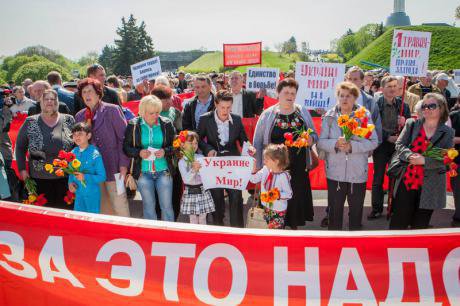
Another question is why anti-communism is a ‘popular’ cause at all. Of course, the armed conflict between Russia and Ukraine is one reason: the war has intensified the identification between ‘communism’ and a ‘pro-Russian’ position in Ukrainian society.
The current taste for anti-communism is no different from the homophobic hysteria of the Yanukovych era. It is a source of political capital.
But if prior to 2014 communist ideology was considered to be the preserve of nostalgic pensioners—a transient phenomenon irrelevant to actual politics, then the conflict has made Ukrainian society take both ‘professional Ukrainians’ and ‘communists’ seriously. The former have become—unexpectedly even for them—a respectable political force, and the latter have come to be seen as a dangerous enemy.
That left-wing ideas are now a casualty of geopolitics isn’t unique to Ukraine. And the divisions between radical nationalists, moderate patriots and pro-Russian forces will set the course of Ukrainian politics for the foreseeable future.
Read more
Get our weekly email
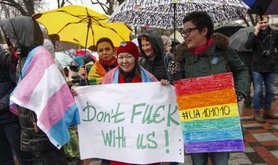
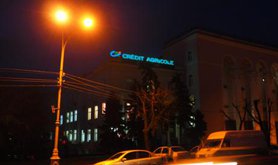

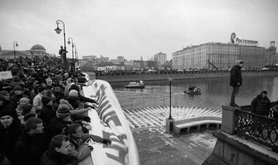
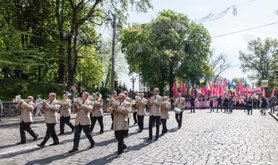

Comments
We encourage anyone to comment, please consult the oD commenting guidelines if you have any questions.